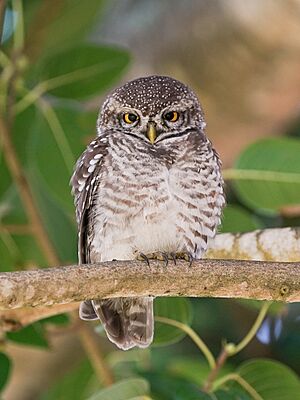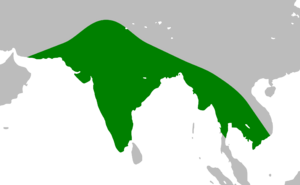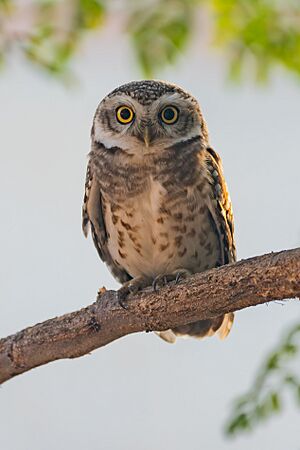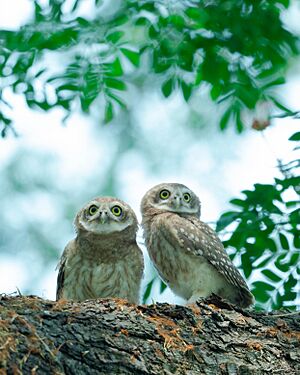Spotted owlet facts for kids
Quick facts for kids Spotted owlet |
|
|---|---|
 |
|
| A. b. indica India | |
| Conservation status | |
| Scientific classification | |
| Genus: |
Athene
|
| Species: |
brama
|
 |
|
| Synonyms | |
|
Carine brama |
|
The spotted owlet (Athene brama) is a small owl found in tropical Asia. You can see them from India all the way to Southeast Asia. These owls often live in open areas like farms and even cities. They are quite good at living near people! Spotted owlets like to rest in small groups. They find cozy spots in tree hollows or cracks in rocks and buildings. When it's time to nest, they lay 3 to 5 eggs in a hole in a tree or building. This owl is very similar to the little owl.
Contents
What Does a Spotted Owlet Look Like?
The spotted owlet is a small, strong bird. It is about 21 cm (8.3 in) tall. Its top feathers are grey-brown with many white spots. The feathers on its belly are white with brown stripes. This owl has a pale face and bright yellow eyes. It also has a white band around its neck and above its eyes. Male and female owlets look very much alike. When they fly, their flight path goes up and down. Owlets from wet areas are darker than those from dry places.
Where Do Spotted Owlets Live?
Scientists have found different types of spotted owlets. These types are called subspecies. They are found in different parts of Asia. For example, one type lives in Iran and Pakistan. Another type lives in northern India. A darker type lives in southern India. There are also types found in Myanmar, Thailand, Cambodia, and Vietnam. The size of these owls gets smaller as you go from north to south. You won't find this owl in Sri Lanka.
How Spotted Owlets Behave
Spotted owlets are mostly active at night. But you can often see them during the day too. If you disturb them, they will bob their heads. They will also stare at you. Other small birds sometimes gather around owlets during the day. This helps people find where the owls are resting.
Their call is loud and sounds like a harsh churring. It ends with a "chirwak-chirwak" sound. They usually call early in the morning or right after the sun sets.
What Do Spotted Owlets Eat?
These owls hunt many different kinds of insects. They also eat small animals with backbones. In Pakistan, they mostly eat insects. In dry areas like Jodhpur, they eat more rodents. This happens especially before they start breeding. They might also eat bats, toads, and small snakes. Sometimes, they even eat scorpions and snails. Owlets nesting near people might have more success. This is because there are more rodents for their babies to eat.
Spotted Owlet Reproduction and Life Cycle
The breeding season for spotted owlets is from November to April. During courtship, the male and female might touch bills. They also preen each other's feathers. The female might call with the male. She may also bob her head and move her tail to invite him.
They build their nests in holes. These holes are often in trees or buildings. They sometimes compete with other birds for these spots. The nest might have leaves and feathers inside. They lay three or four round, white eggs. The eggs are about 30.9 mm long and 26.3 mm wide. The mother starts sitting on the eggs as soon as the first one is laid. This means the chicks hatch at different times. So, the baby owls can be different sizes.
The young owlets first eat insects like cockroaches. Later, they eat small animals like mice. Only one or two chicks usually survive and leave the nest. They leave the nest when they are about one month old.
Spotted Owlets in Culture
These birds are very common near people. Their loud calls have made some people think they bring bad luck. The name "brama" for this owl comes from a French name. It also honors Brahma, an important spirit in the Hindu religion.




